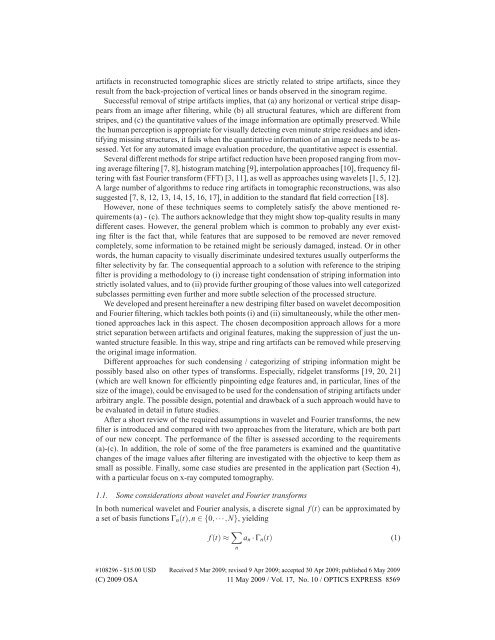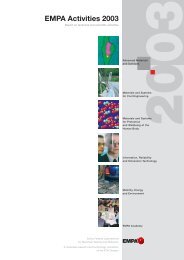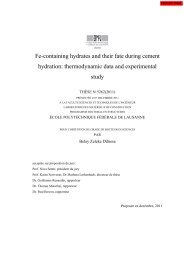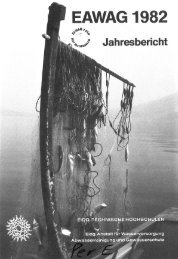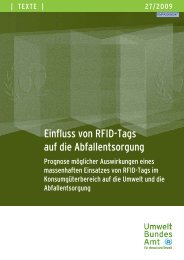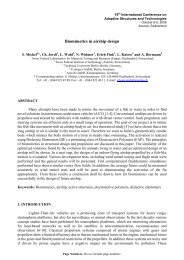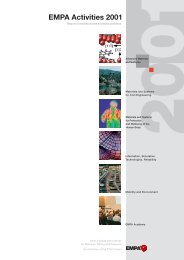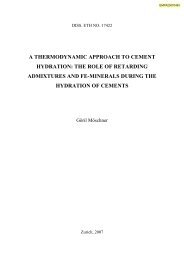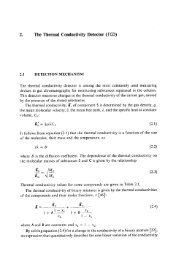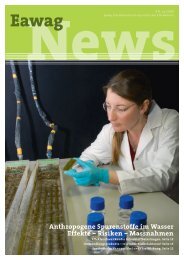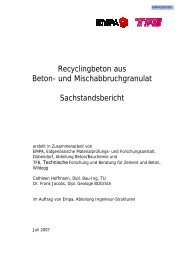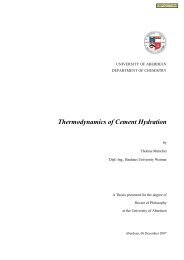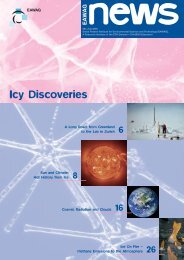Stripe and ring artifact removal with combined wavelet — Fourier ...
Stripe and ring artifact removal with combined wavelet — Fourier ...
Stripe and ring artifact removal with combined wavelet — Fourier ...
You also want an ePaper? Increase the reach of your titles
YUMPU automatically turns print PDFs into web optimized ePapers that Google loves.
<strong>artifact</strong>s in reconstructed tomographic slices are strictly related to stripe <strong>artifact</strong>s, since they<br />
result from the back-projection of vertical lines or b<strong>and</strong>s observed in the sinogram regime.<br />
Successful <strong>removal</strong> of stripe <strong>artifact</strong>s implies, that (a) any horizonal or vertical stripe disappears<br />
from an image after filte<strong>ring</strong>, while (b) all structural features, which are different from<br />
stripes, <strong>and</strong> (c) the quantitative values of the image information are optimally preserved. While<br />
the human perception is appropriate for visually detecting even minute stripe residues <strong>and</strong> identifying<br />
missing structures, it fails when the quantitative information of an image needs to be assessed.<br />
Yet for any automated image evaluation procedure, the quantitative aspect is essential.<br />
Several different methods for stripe <strong>artifact</strong> reduction have been proposed ranging from moving<br />
average filte<strong>ring</strong> [7, 8], histogram matching [9], interpolation approaches [10], frequency filte<strong>ring</strong><br />
<strong>with</strong> fast <strong>Fourier</strong> transform (FFT) [3, 11], as well as approaches using <strong>wavelet</strong>s [1, 5, 12].<br />
A large number of algorithms to reduce <strong>ring</strong> <strong>artifact</strong>s in tomographic reconstructions, was also<br />
suggested [7, 8, 12, 13, 14, 15, 16, 17], in addition to the st<strong>and</strong>ard flat field correction [18].<br />
However, none of these techniques seems to completely satisfy the above mentioned requirements<br />
(a) - (c). The authors acknowledge that they might show top-quality results in many<br />
different cases. However, the general problem which is common to probably any ever existing<br />
filter is the fact that, while features that are supposed to be removed are never removed<br />
completely, some information to be retained might be seriously damaged, instead. Or in other<br />
words, the human capacity to visually discriminate undesired textures usually outperforms the<br />
filter selectivity by far. The consequential approach to a solution <strong>with</strong> reference to the striping<br />
filter is providing a methodology to (i) increase tight condensation of striping information into<br />
strictly isolated values, <strong>and</strong> to (ii) provide further grouping of those values into well categorized<br />
subclasses permitting even further <strong>and</strong> more subtle selection of the processed structure.<br />
We developed <strong>and</strong> present hereinafter a new destriping filter based on <strong>wavelet</strong> decomposition<br />
<strong>and</strong> <strong>Fourier</strong> filte<strong>ring</strong>, which tackles both points (i) <strong>and</strong> (ii) simultaneously, while the other mentioned<br />
approaches lack in this aspect. The chosen decomposition approach allows for a more<br />
strict separation between <strong>artifact</strong>s <strong>and</strong> original features, making the suppression of just the unwanted<br />
structure feasible. In this way, stripe <strong>and</strong> <strong>ring</strong> <strong>artifact</strong>s can be removed while preserving<br />
the original image information.<br />
Different approaches for such condensing / categorizing of striping information might be<br />
possibly based also on other types of transforms. Especially, ridgelet transforms [19, 20, 21]<br />
(which are well known for efficiently pinpointing edge features <strong>and</strong>, in particular, lines of the<br />
size of the image), could be envisaged to be used for the condensation of striping <strong>artifact</strong>s under<br />
arbitrary angle. The possible design, potential <strong>and</strong> drawback of a such approach would have to<br />
be evaluated in detail in future studies.<br />
After a short review of the required assumptions in <strong>wavelet</strong> <strong>and</strong> <strong>Fourier</strong> transforms, the new<br />
filter is introduced <strong>and</strong> compared <strong>with</strong> two approaches from the literature, which are both part<br />
of our new concept. The performance of the filter is assessed according to the requirements<br />
(a)-(c). In addition, the role of some of the free parameters is examined <strong>and</strong> the quantitative<br />
changes of the image values after filte<strong>ring</strong> are investigated <strong>with</strong> the objective to keep them as<br />
small as possible. Finally, some case studies are presented in the application part (Section 4),<br />
<strong>with</strong> a particular focus on x-ray computed tomography.<br />
1.1. Some considerations about <strong>wavelet</strong> <strong>and</strong> <strong>Fourier</strong> transforms<br />
In both numerical <strong>wavelet</strong> <strong>and</strong> <strong>Fourier</strong> analysis, a discrete signal f(t) can be approximated by<br />
a set of basis functions Γn(t),n ∈ {0,···,N}, yielding<br />
f(t) ≈ <br />
an · Γn(t) (1)<br />
n<br />
#108296 - $15.00 USD Received 5 Mar 2009; revised 9 Apr 2009; accepted 30 Apr 2009; published 6 May 2009<br />
(C) 2009 OSA 11 May 2009 / Vol. 17, No. 10 / OPTICS EXPRESS 8569


